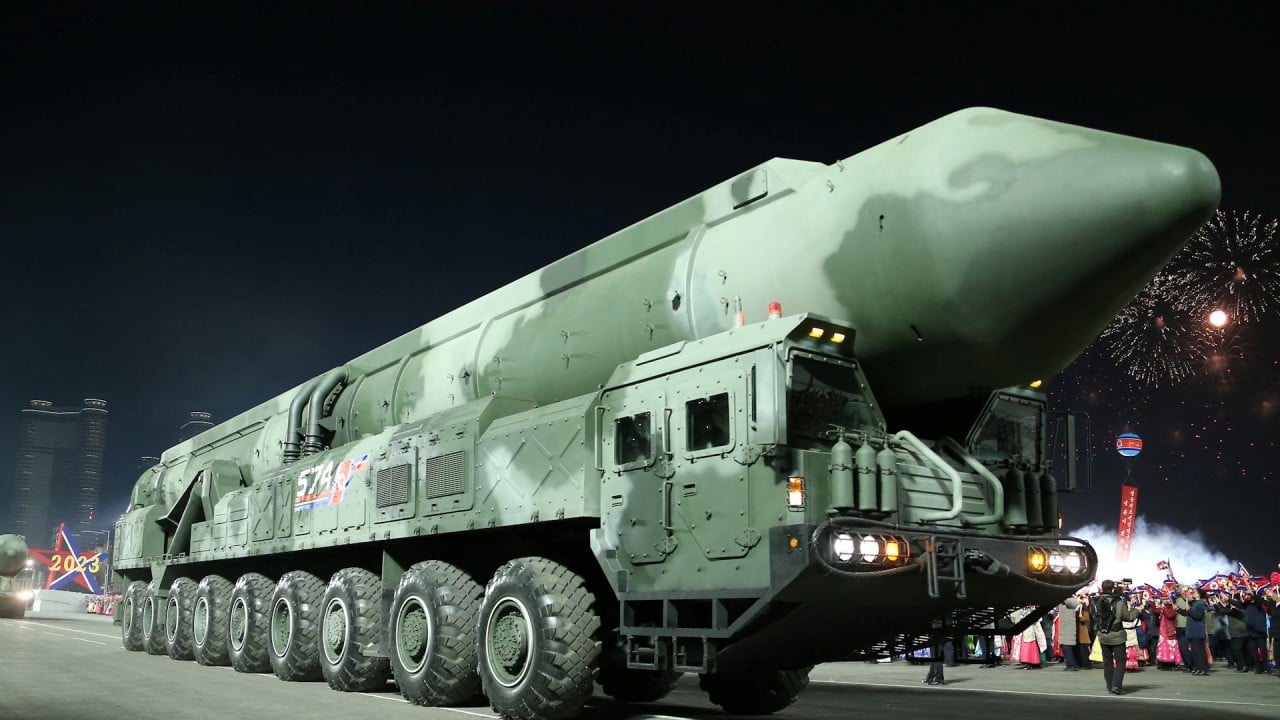
South Korea, US stage combined air drill in response to North Korea missile launch
- State news agency KCNA called the launch a ‘guarantee for and a clear proof of the sure reliability of our powerful physical nuclear deterrent’
- US Secretary of State Antony Blinken described the launch as a ‘provocative’ act in remarks alongside his counterparts from Japan and South Korea on Saturday
South Korea and the United States held a combined air drill involving a US strategic bomber on Sunday in response to North Korea’s launch of an intercontinental ballistic missile on Saturday, South Korea’s military said.
North Korea said on Sunday it had fired a Hwasong-15 intercontinental ballistic missile (ICBM) the day before in a “sudden launching drill” that confirmed its readiness for “mobile and mighty counter-attack” against hostile forces.
North Korea launched a long-range ballistic missile into the sea off Japan’s west coast on Saturday afternoon after warning of a strong response to coming military drills by South Korea and the United States.
“The surprise ICBM launching drill … is an actual proof of the DPRK strategic nuclear force’s consistent efforts to turn its capacity of fatal nuclear counter-attack on the hostile forces into the irresistible one,” the state news agency KCNA said, using the abbreviation for the North’s official name, the Democratic People’s Republic of Korea.

Leader Kim Jong-un’s sister, Kim Yo-jong, bristled at the United States for trying to turn the UN Security Council into what she called a “tool for its heinous hostile policy” toward Pyongyang.
“I warn that we will watch every movement of the enemy and take corresponding and very powerful and overwhelming counteraction against its every move hostile to us,” she said in a statement.
Saturday’s missile launch, the North’s first since January 1, came after Pyongyang threatened on Friday an “unprecedentedly persistent, strong” response as South Korea and the United States for annual military exercises as part of efforts to fend off the North’s growing nuclear and missile threats.
The state news agency said the missile had flown for 1 hour, 6 minutes and 55 seconds, as high as 5,768km (3,584 miles), before accurately hitting a preset area 989km (614 miles) away in open waters. Hwasong-15 was first tested in 2017.
Japanese said on Saturday the missile had plunged into waters inside its exclusive economic zone.
North Korea fires unspecified ballistic missile, lands in Japan’s EEZ
‘Without warning’
Nuclear-armed North Korea fired an unprecedented number of missiles last year, including ICBMs capable of striking anywhere in the United States, while resuming preparations for its first nuclear test since 2017.
South Korean Foreign Minister Park Jin said on Saturday’s launch “clearly” signals the North’s intent to conduct additional provocations.
“If North Korea conducts the seventh nuclear test, which could happen at any time, it will be a game changer in a sense that North Korea could develop and deploy tactical nuclear missiles,” Park told the Munich Security Conference on Saturday.
The launch, guided by the Missile General Bureau, was conducted on an “emergency firepower combat standby order” given at dawn, followed by a written order from Kim Jong-un at 8am (2300 GMT on Friday), KCNA said. South Korea’s military said it detected the missile at 5:22pm (0822 GMT).
“The important bit here is that the exercise was ordered day-of, without warning to the crew involved,” said Ankit Panda, a missile expert at the Washington – based Carnegie Endowment for International Peace. “The amount of time between the order and the launch is likely going to be decreased with additional testing.”
The military unit got an “excellent mark” over the drill and the North’s ruling party “highly appreciated the actual war capacity of the ICBM units which are ready for mobile and mighty counter-attack,” KCNA said.
Analysts say North Korea is likely to conduct more weapons tests, including a possible new solid-fuel missile which could help the North deploy its missiles faster in the event of a war.
As North Korea unveils stamps of Kim’s daughter, South doubts she is successor
North Korea’s ballistic missile and nuclear weapons programmes are banned under UN Security Council resolutions, but Pyongyang says its weapons development is necessary to counter “hostile policies” by Washington and its allies.
US Secretary of State Antony Blinken described the launch as a “provocative” act.
“The result of these actions by North Korea is simply to even further solidify the work that we do together, the alliance that we share, and our commitment to the defence of our partners and allies,” Blinken said on the sidelines of the Munich Security Conference in Germany.
“Countries that have influence with North Korea should use it to try to move it from the course that it’s been on now for the last couple of years,” Blinken said.


